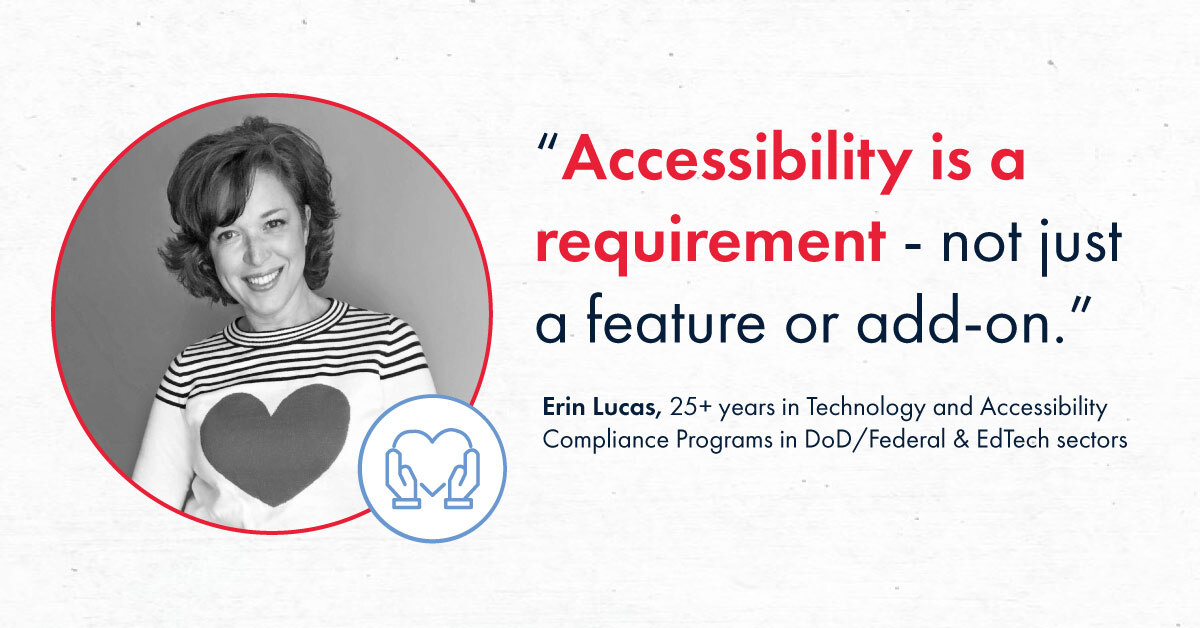In an exclusive interview, Erin Lucas, discusses why "accessibility is a requirement and not just a feature or add-on." Erin has spent 20+ years of her career creating and managing technology and accessibility compliance programs.
Why is Accessibility Important?
EL: Accessibility (a11y) is a basic human right. One in seven of us has some sort of disability, yet less than a quarter of that number actually self-identifies and/or reaches out for accommodations and support. So, for millions of people with disabilities, effective access to natively accessible course materials can be the difference between academic success and failure. For campus accessibility offices and course material managers, it’s crucial to work with a course materials distribution partner who understands the high-stakes nature of accessible learning content.
Providing digital course materials is an approach that is gaining popularity across higher education, helping institutions improve affordability, learner engagement, and more. But to meet the needs of all students, including those with disabilities, an accessibility-first mindset must be woven into both the digital content as well as the institutional culture.
How does your/the RedShelf approach differ from the masses? How does it set us apart?
EL: For one, RedShelf, takes an accessibility-first approach to software development. While many tech companies see accessibility as just a feature or last-minute add-on, we see it as a requirement. For our teams, a11y is being included throughout the product life cycle. It's integral to what we do. Further, we’re providing a more holistic approach than many other providers, directly engaging with and supporting the collective publishing and campus ecosystems.
It all starts with accessible content. We proactively encourage our publisher partners to provide “born accessible” EPUB content—the best way to ensure all students have equal and effective access to learning. Because, in the end, even the most accessible eReader won’t “fix” inaccessible content. Driving the creation and adoption of EPUB has led to vast improvements in the accessibility of the RedShelf catalog. It’s really encouraging that so many publishers recognize the many benefits of EPUB and, thanks to this shift, we have seen an incredible change in the inclusivity of our catalog. That assortment has grown from only 40% EPUB to 82% EPUB in just four years!
While we may pause for a quick celebration of that accomplishment, there’s more work to be done. RedShelf believes in efforts that educate—because they can also lead to healthy conversations for the industry. We’ve spearheaded conversations with a11y organizations to develop a standard for the display of a11y metadata, and contributed to the W3C Standard for the display of a11y metadata. And it's just the beginning; our partners can expect that industry-leading approach to continue in the years ahead.
In the higher education space, RedShelf leads by delivering a more intimate and hands-on approach. The Disability Services Office (DSO) is the essential conduit between students and the most accessible, effective materials. RedShelf makes it a priority to connect directly with the DSO to understand their needs and the needs of their students. Accommodations can often be time-consuming and challenging without support like ours. To ensure success for all students, RedShelf has partnered with publishers to create our a11y Student Accommodation Program (ASAP) for all campus partners. RedShelf’s ASAP has reshaped the way we and our campus partners support local students and campus DSOs. In addition, our campus partners gain access to a11y-related training and webinars—for Course Materials Managers, Instructors, and others—to help them understand the importance of a11y in the process of considering and adopting digital content.
What does this mean for the campus store?
EL: The idea of delivering affordable and accessible content is likely top-of-mind for many readers, and it's not just a passing fad. It will only gain increasing attention as campuses expand their use of educational technology and digital learning content. For the campus store, a11y presents an opportunity to demonstrate their expertise and add even more value for students, faculty, and administration. Partners like RedShelf can help stores establish themselves as leaders in ensuring every student has an equivalent opportunity to succeed.
